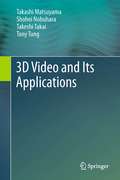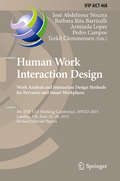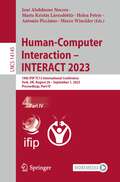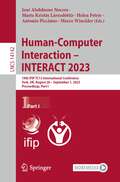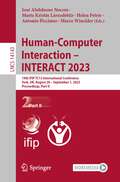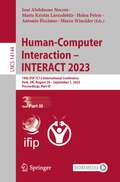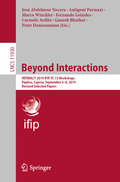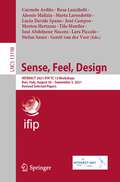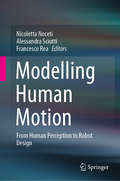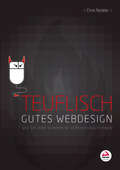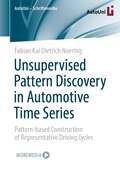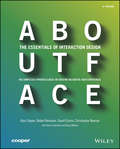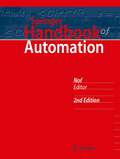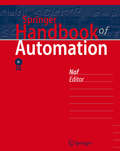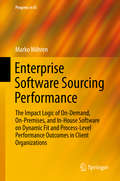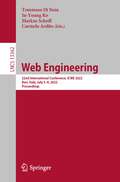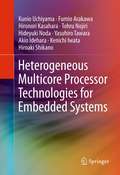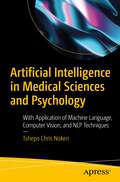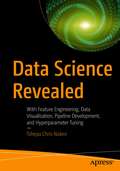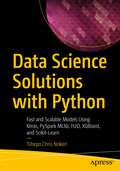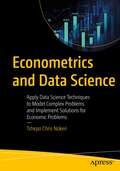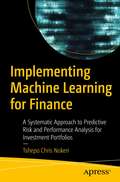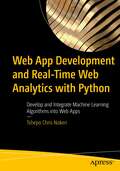- Table View
- List View
3D Video and Its Applications
by Shohei Nobuhara Tony Tung Takashi Matsuyama Takeshi TakaiThis book presents a broad review of state-of-the-art 3D video production technologies and applications. The text opens with a concise introduction to the field, before examining the design and calibration methods for multi-view camera systems, including practical implementation technologies. A range of algorithms are then described for producing 3D video from video data. A selection of 3D video applications are also demonstrated. Features: describes real-time synchronized multi-view video capture, and object tracking with a group of active cameras; discusses geometric and photometric camera calibration, and 3D video studio design with active cameras; examines 3D shape and motion reconstruction, texture mapping and image rendering, and lighting environment estimation; demonstrates attractive 3D visualization, visual contents analysis and editing, 3D body action analysis, and data compression; highlights the remaining challenges and the exciting avenues for future research in 3D video technology.
Human Work Interaction Design. Work Analysis and Interaction Design Methods for Pervasive and Smart Workplaces
by José Abdelnour Nocera Barbara Rita Barricelli Arminda Lopes Pedro Campos Torkil ClemmensenThis book constitutes the thoroughly refereed post-conference proceedings of the 4th IFIP WG 13. 6 Working Conference on Human Work Interaction Design, HWID 2015, held in London, UK, in June 2015. The 15 revised full papers presented were carefully selected for inclusion in this volume. The papers reflect many different areas and address many complex and diverse work domains, focusing on the integration of work analysis and interaction design methods for pervasive and smart workplaces. They are organized in the following sections: methodologies; environment, and specific contexts.
Human-Computer Interaction – INTERACT 2023: 19th IFIP TC13 International Conference, York, UK, August 28 – September 1, 2023, Proceedings, Part IV (Lecture Notes in Computer Science #14145)
by José Abdelnour Nocera Marta Kristín Lárusdóttir Helen Petrie Antonio Piccinno Marco WincklerThe four-volume set LNCS 14442 -14445 constitutes the proceedings of the 19th IFIP TC 13 International Conference on Human-Computer Interaction, INTERACT 2023, held in York, UK, in August/September 2023. The 71 full papers and 58 short papers included in this book were carefully reviewed and selected from 406 submissions. They were organized in topical sections as follows: 3D Interaction; Accessibility; Accessibility and Aging; Accessibility for Auditory/Hearing Disabilities; Co-Design; Cybersecurity and Trust; Data Physicalisation and Cross-device; Eye-Free, Gesture Interaction and Sign Language; Haptic interaction and Healthcare applications; Self-Monitoring; Human-Robot Interaction; Information Visualization; Information Visualization and 3D Interaction; Interacting with Children; Interaction with Conversational Agents; Methodologies for HCI; Model-Based UI Design and Testing; Montion Sickness, Stress and Risk perception in 3D Environments and Multisensory interaction; VR experiences; Natural Language Processing and AI Explainability; Online Collaboration and Cooperative work; Recommendation Systems and AI Explainability; Social AI; Social and Ubiquitous Computing; Social Media and Digital Learning; Understanding Users and Privacy Issues; User movement and 3D Environments; User Self-Report; User Studies; User Studies, Eye-Tracking, and Physiological Data; Virtual Reality; Virtual Reality and Training; Courses; Industrial Experiences; Interactive Demonstrations; Keynotes; Panels; Posters; and Workshops.
Human-Computer Interaction – INTERACT 2023: 19th IFIP TC13 International Conference, York, UK, August 28 – September 1, 2023, Proceedings, Part I (Lecture Notes in Computer Science #14142)
by José Abdelnour Nocera Marta Kristín Lárusdóttir Helen Petrie Antonio Piccinno Marco WincklerThe four-volume set LNCS 14442 -14445 constitutes the proceedings of the 19th IFIP TC 13 International Conference on Human-Computer Interaction, INTERACT 2023, held in York, UK, in August/September 2023. The 71 full papers and 58 short papers included in this book were carefully reviewed and selected from 406 submissions. They were organized in topical sections as follows: 3D Interaction; Accessibility; Accessibility and Aging; Accessibility for Auditory/Hearing Disabilities; Co-Design; Cybersecurity and Trust; Data Physicalisation and Cross-device; Eye-Free, Gesture Interaction and Sign Language; Haptic interaction and Healthcare applications; Self-Monitoring; Human-Robot Interaction; Information Visualization; Information Visualization and 3D Interaction; Interacting with Children; Interaction with Conversational Agents; Methodologies for HCI; Model-Based UI Design and Testing; Montion Sickness, Stress and Risk perception in 3D Environments and Multisensory interaction; VR experiences; Natural Language Processing and AI Explainability; Online Collaboration and Cooperative work; Recommendation Systems and AI Explainability; Social AI; Social and Ubiquitous Computing; Social Media and Digital Learning; Understanding Users and Privacy Issues; User movement and 3D Environments; User Self-Report; User Studies; User Studies, Eye-Tracking, and Physiological Data; Virtual Reality; Virtual Reality and Training; Courses; Industrial Experiences; Interactive Demonstrations; Keynotes; Panels; Posters; and Workshops.
Human-Computer Interaction – INTERACT 2023: 19th IFIP TC13 International Conference, York, UK, August 28 – September 1, 2023, Proceedings, Part II (Lecture Notes in Computer Science #14143)
by José Abdelnour Nocera Marta Kristín Lárusdóttir Helen Petrie Antonio Piccinno Marco WincklerThe four-volume set LNCS 14442 -14445 constitutes the proceedings of the 19th IFIP TC 13 International Conference on Human-Computer Interaction, INTERACT 2023, held in York, UK, in August/September 2023. The 71 full papers and 58 short papers included in this book were carefully reviewed and selected from 406 submissions. They were organized in topical sections as follows: 3D Interaction; Accessibility; Accessibility and Aging; Accessibility for Auditory/Hearing Disabilities; Co-Design; Cybersecurity and Trust; Data Physicalisation and Cross-device; Eye-Free, Gesture Interaction and Sign Language; Haptic interaction and Healthcare applications; Self-Monitoring; Human-Robot Interaction; Information Visualization; Information Visualization and 3D Interaction; Interacting with Children; Interaction with Conversational Agents; Methodologies for HCI; Model-Based UI Design and Testing; Montion Sickness, Stress and Risk perception in 3D Environments and Multisensory interaction; VR experiences; Natural Language Processing and AI Explainability; Online Collaboration and Cooperative work; Recommendation Systems and AI Explainability; Social AI; Social and Ubiquitous Computing; Social Media and Digital Learning; Understanding Users and Privacy Issues; User movement and 3D Environments; User Self-Report; User Studies; User Studies, Eye-Tracking, and Physiological Data; Virtual Reality; Virtual Reality and Training; Courses; Industrial Experiences; Interactive Demonstrations; Keynotes; Panels; Posters; and Workshops.
Human-Computer Interaction – INTERACT 2023: 19th IFIP TC13 International Conference, York, UK, August 28 – September 1, 2023, Proceedings, Part III (Lecture Notes in Computer Science #14144)
by José Abdelnour Nocera Marta Kristín Lárusdóttir Helen Petrie Antonio Piccinno Marco WincklerThe four-volume set LNCS 14442 -14445 constitutes the proceedings of the 19th IFIP TC 13 International Conference on Human-Computer Interaction, INTERACT 2023, held in York, UK, in August/September 2023. The 71 full papers and 58 short papers included in this book were carefully reviewed and selected from 406 submissions. They were organized in topical sections as follows: 3D Interaction; Accessibility; Accessibility and Aging; Accessibility for Auditory/Hearing Disabilities; Co-Design; Cybersecurity and Trust; Data Physicalisation and Cross-device; Eye-Free, Gesture Interaction and Sign Language; Haptic interaction and Healthcare applications; Self-Monitoring; Human-Robot Interaction; Information Visualization; Information Visualization and 3D Interaction; Interacting with Children; Interaction with Conversational Agents; Methodologies for HCI; Model-Based UI Design and Testing; Montion Sickness, Stress and Risk perception in 3D Environments and Multisensory interaction; VR experiences; Natural Language Processing and AI Explainability; Online Collaboration and Cooperative work; Recommendation Systems and AI Explainability; Social AI; Social and Ubiquitous Computing; Social Media and Digital Learning; Understanding Users and Privacy Issues; User movement and 3D Environments; User Self-Report; User Studies; User Studies, Eye-Tracking, and Physiological Data; Virtual Reality; Virtual Reality and Training; Courses; Industrial Experiences; Interactive Demonstrations; Keynotes; Panels; Posters; and Workshops.
Beyond Interactions: INTERACT 2019 IFIP TC 13 Workshops, Paphos, Cyprus, September 2–6, 2019, Revised Selected Papers (Lecture Notes in Computer Science #11930)
by José Abdelnour Nocera Antigoni Parmaxi Marco Winckler Fernando Loizides Carmelo Ardito Ganesh Bhutkar Peter DannenmannThis book contains revised selected papers presented at 3 workshops held at the 17th IFIP TC 13 International Conference on Human-Computer Interaction, INTERACT 2019, which was held in September 2019 in Paphos, Cyprus. The workshops are: - Beyond Computers: Wearables, Humans, And Things - WHAT! - User Experiences and Wellbeing at Work (UX@Work) - Workshop on Handling Security, Usability, User Experience and Reliability in User-Centered Development Processes. The 12 papers included in this volume were carefully reviewed and selected from numerous submissions. They show advances in the field of HCI dealing with topics such as wearables, user experience and wellbeing at work, security, usability, user experience and reliability in user-centered development processes.
Sense, Feel, Design: INTERACT 2021 IFIP TC 13 Workshops, Bari, Italy, August 30 – September 3, 2021, Revised Selected Papers (Lecture Notes in Computer Science #13198)
by José Abdelnour Nocera Stefan Sauer Alessio Malizia Carmelo Ardito José Campos Rosa Lanzilotti Marta Larusdottir Lucio Davide Spano Morten Hertzum Tilo Mentler Lara Piccolo Gerrit van der VeerThis book contains a series of revised papers selected from 7 workshops organized by 18th IFIP TC 13 International Conference on Human-Computer Interaction, INTERACT 2021, which was held in September 2021 in Bari, Italy. The 15 papers included in this volume were carefully reviewed and selected from 30 submissions. They show the design of interactive technologies addressing one or more United Nations' Sustainable Development Goals, to deal with evolving contexts of use in today’s and future application domains and its influence on human-centered socio-technical system design and devel-opment practice, share educational resources and approaches to support the process of teaching and learning HCI Engineering (HCI-E), share educational resources and approaches to support the process of teaching and learning HCI Engineering (HCI-E), and address and discuss geopolitical issues in Human-Computer Interaction as a field of knowledge and practice.
Modelling Human Motion: From Human Perception to Robot Design
by Nicoletta Noceti Alessandra Sciutti Francesco ReaThe new frontiers of robotics research foresee future scenarios where artificial agents will leave the laboratory to progressively take part in the activities of our daily life. This will require robots to have very sophisticated perceptual and action skills in many intelligence-demanding applications, with particular reference to the ability to seamlessly interact with humans. It will be crucial for the next generation of robots to understand their human partners and at the same time to be intuitively understood by them. In this context, a deep understanding of human motion is essential for robotics applications, where the ability to detect, represent and recognize human dynamics and the capability for generating appropriate movements in response sets the scene for higher-level tasks. This book provides a comprehensive overview of this challenging research field, closing the loop between perception and action, and between human-studies and robotics. The book is organized in three main parts. The first part focuses on human motion perception, with contributions analyzing the neural substrates of human action understanding, how perception is influenced by motor control, and how it develops over time and is exploited in social contexts. The second part considers motion perception from the computational perspective, providing perspectives on cutting-edge solutions available from the Computer Vision and Machine Learning research fields, addressing higher-level perceptual tasks. Finally, the third part takes into account the implications for robotics, with chapters on how motor control is achieved in the latest generation of artificial agents and how such technologies have been exploited to favor human-robot interaction. This book considers the complete human-robot cycle, from an examination of how humans perceive motion and act in the world, to models for motion perception and control in artificial agents. In this respect, the book will provide insights into the perception and action loop in humans and machines, joining together aspects that are often addressed in independent investigations. As a consequence, this book positions itself in a field at the intersection of such different disciplines as Robotics, Neuroscience, Cognitive Science, Psychology, Computer Vision, and Machine Learning. By bridging these different research domains, the book offers a common reference point for researchers interested in human motion for different applications and from different standpoints, spanning Neuroscience, Human Motor Control, Robotics, Human-Robot Interaction, Computer Vision and Machine Learning.Chapter 'The Importance of the Affective Component of Movement in Action Understanding' of this book is available open access under a CC BY 4.0 license at link.springer.com.
Evil by Design
by Chris NodderHow to make customers feel good about doing what you wantLearn how companies make us feel good about doing what they want. Approaching persuasive design from the dark side, this book melds psychology, marketing, and design concepts to show why we're susceptible to certain persuasive techniques. Packed with examples from every nook and cranny of the web, it provides easily digestible and applicable patterns for putting these design techniques to work. Organized by the seven deadly sins, it includes:Pride -- use social proof to position your product in line with your visitors' valuesSloth -- build a path of least resistance that leads users where you want them to goGluttony -- escalate customers' commitment and use loss aversion to keep them thereAnger -- understand the power of metaphysical arguments and anonymityEnvy -- create a culture of status around your product and feed aspirational desiresLust -- turn desire into commitment by using emotion to defeat rational behaviorGreed -- keep customers engaged by reinforcing the behaviors you desireNow you too can leverage human fallibility to create powerful persuasive interfaces that people will love to use -- but will you use your new knowledge for good or evil? Learn more on the companion website, evilbydesign.info.
Teuflisch gutes Webdesign: Wie Sie Ihre Kunden in Versuchung führen
by Chris Nodder»Lesen Sie besser dieses Buch, bevor Sie jemand über den Tisch zieht. Wenn diese Angst nicht reicht, wird Gier vielleicht den Zweck erfüllen: Durch die Regeln dieses Buchs wird jede Website eine Menge Geld machen, selbst wenn Sie nicht vollständig dem Bösen verfallen.« Jakob Nielsen, Autor von »Designing Web Usability« und »Mobile Usability« »Aufschlussreich, lustig und spannend … Dieses Buch zeigt Ihnen, wie Sie schon ausgetrickst worden sind und, noch viel besser, wie Sie selbst andere Menschen dazu bringen, etwas zu tun – sei es zum Bösen oder (wenn es denn unbedingt sein muss) zum Guten.« Bruce »Tog« Tognazzini, Mitinhaber der Nielsen Norman Group und ehemaliger Apple-Mitarbeiter Nr. 66 Erfolgreichere Websites durch die Kunst der Verführung Ihre Kunden sollen Ihre Website lieben? Sich dort so richtig wohlfühlen – und dabei das tun, was Sie von ihnen möchten? In einer furiosen Mischung aus Psychologie, Marketing und Design zeigt Ihnen Chris Nodder, wie Sie das erreichen. Die einfach umzusetzenden Designmuster, die er Ihnen an die Hand gibt, bauen auf den kleinen Schwächen auf, die wir alle haben: Wir möchten dazugehören, uns nicht allzu sehr anstrengen, Schnäppchen machen, nicht Nein sagen müssen und vieles mehr. An unzähligen Beispielen aus allen Schlupfwinkeln des Internets lernen Sie, wie Sie die Usability Ihrer Website verbessern, indem Sie diese Schwächen berücksichtigen – oder wie Sie Ihre Kunden dadurch verleiten können. Der Erfolg ist Ihnen in jedem Fall sicher, es liegt also an Ihnen: Wie werden Sie Ihr neues Wissen einsetzen? Zum Guten oder zum Bösen? Stolz: Den Wunsch nach Zugehörigkeit nutzen Trägheit: Verhalten durch Auswahlhilfen lenken Völlerei: Mit Belohnungen arbeiten Zorn: Ärger vermeiden und entschärfen Neid: Begehrlichkeiten wecken Lust: Sympathie erzeugen und erhalten Gier: Gewünschtes Verhalten bestärken
Unsupervised Pattern Discovery in Automotive Time Series: Pattern-based Construction of Representative Driving Cycles (AutoUni – Schriftenreihe #159)
by Fabian Kai NoeringIn the last decade unsupervised pattern discovery in time series, i.e. the problem of finding recurrent similar subsequences in long multivariate time series without the need of querying subsequences, has earned more and more attention in research and industry. Pattern discovery was already successfully applied to various areas like seismology, medicine, robotics or music. Until now an application to automotive time series has not been investigated. This dissertation fills this desideratum by studying the special characteristics of vehicle sensor logs and proposing an appropriate approach for pattern discovery. To prove the benefit of pattern discovery methods in automotive applications, the algorithm is applied to construct representative driving cycles.
About Face: The Essentials of Interaction Design
by Christopher Noessel Alan Cooper Robert Reimann David CroninAbout Face: The Essentials of Interaction Design, Fourth Edition is the latest update to the book that shaped and evolved the landscape of interaction design. This comprehensive guide takes the worldwide shift to smartphones and tablets into account. New information includes discussions on mobile apps, touch interfaces, screen size considerations, and more. The new full-color interior and unique layout better illustrate modern design concepts. <p><p> The interaction design profession is blooming with the success of design-intensive companies, priming customers to expect "design" as a critical ingredient of marketplace success. Consumers have little tolerance for websites, apps, and devices that don't live up to their expectations, and the responding shift in business philosophy has become widespread. About Face is the book that brought interaction design out of the research labs and into the everyday lexicon, and the updated Fourth Edition continues to lead the way with ideas and methods relevant to today's design practitioners and developers.
Springer Handbook of Automation (Springer Handbooks)
by Shimon Y. NofThis handbook incorporates new developments in automation. It also presents a widespread and well-structured conglomeration of new emerging application areas, such as medical systems and health, transportation, security and maintenance, service, construction and retail as well as production or logistics. The handbook is not only an ideal resource for automation experts but also for people new to this expanding field.
Springer Handbook of Automation
by Shimon Y. NofThis handbook incorporates new developments in automation. It also presents a widespread and well-structured conglomeration of new emerging application areas, such as medical systems and health, transportation, security and maintenance, service, construction and retail as well as production or logistics. The handbook is not only an ideal resource for automation experts but also for people new to this expanding field.
Designing Topological Phase of Bismuth Halides and Controlling Rashba Effect in Films Studied by ARPES (Springer Theses)
by Ryo NoguchiThis book presents the observation and the control of spin-polarized electrons in Rashba thin films and topological insulators, including the first observations of a weak topological insulator (WTI) and a higher-order topological insulator (HOTI) in bismuth halides. It begins with a general review of electronic structures at the solid surface and mentions that an electron spin at a surface is polarized due to the Rashba effect or topological insulator states with strong spin-orbit coupling. Subsequently it describes the experimental techniques used to study these effects, that is, angle-resolved photoemission spectroscopy (ARPES). Further it moves its focus onto the experimental investigations, in which mainly two different systems—noble metal thin films with the Rashba effects and bismuth halides topological insulators—are used. The study of the first system discusses the role of wavefunctions in spin-splitting and demonstrates a scaling law for the Rashba effect in quantum well films for the first time. High-resolution spin-resolved ARPES plays a vital role in systematically trace the thickness-evolution of the effect. The study of the latter material is the first experimental demonstration of both a WTI and HOTI state in bismuth iodide and bismuth bromide, respectively. Importantly, nano-ARPES with high spatial resolution is used to confirm the topological surface states on the side surface of the crystal, which is the hallmark of WTIs.The description of the basic and recently-developed ARPES technique with spin-resolution or spatial-resolution, essential in investigating spin-polarized electrons at a crystal surface, makes the book a valuable source for researchers not only in surface physics or topological materials but also in spintronics and other condensed-matter physics.
Enterprise Software Sourcing Performance
by Marko NöhrenThis book opens the "black box" of software sourcing by explaining how dynamic software alignment is established and how it impacts business performance outcomes. By investigating how software-sourcing modes are related to value generation in the post-implementation phase, it shows researchers and managers the impact logic of on-demand, on-premises, and in-house software on dynamic fit and process-level performance outcomes in a client organization. It describes dynamic IT alignment as the key to success in a fast-moving digital world with software-as-a-service on the rise and highlights the fact that today companies can choose between developing software in-house (make) or sourcing packaged systems in an on-premises (buy) or an on-demand (lease) mode. This book is the first to explicitly compare these sourcing arrangements with each other in terms of alignment and business performance.
Web Engineering: 22nd International Conference, ICWE 2022, Bari, Italy, July 5–8, 2022, Proceedings (Lecture Notes in Computer Science #13362)
by Tommaso Di Noia In-Young Ko Markus Schedl Carmelo ArditoThis book constitutes the thoroughly refereed proceedings of the 22nd International Conference on Web Engineering, ICWE 2022, held in Bari, Italy, in July 2022. The 23 revised full papers and 5 short papers presented were carefully reviewed and selected from 81 submissions. The books also contains 6 demonstration and poster papers, 7 symposium and 5 tutorial papers. They are organized in topical sections named: recommender systems based on web technology; social web applications; web applications modelling and engineering; web big data and web data analytics; web mining and knowledge extraction; web security and privacy; web user interfaces.
Heterogeneous Multicore Processor Technologies for Embedded Systems
by Tohru Nojiri Kenichi Iwata Fumio Arakawa Yasuhiro Tawara Kunio Uchiyama Hironori Kasahara Hiroaki Shikano Hideyuki Noda Akio IdeharaTo satisfy the higher requirements of digitally converged embedded systems, this book describes heterogeneous multicore technology that uses various kinds of low-power embedded processor cores on a single chip. With this technology, heterogeneous parallelism can be implemented on an SoC, and greater flexibility and superior performance per watt can then be achieved. This book defines the heterogeneous multicore architecture and explains in detail several embedded processor cores including CPU cores and special-purpose processor cores that achieve highly arithmetic-level parallelism. The authors developed three multicore chips (called RP-1, RP-2, and RP-X) according to the defined architecture with the introduced processor cores. The chip implementations, software environments, and applications running on the chips are also explained in the book. Provides readers an overview and practical discussion of heterogeneous multicore technologies from both a hardware and software point of view;Discusses a new, high-performance and energy efficient approach to designing SoCs for digitally converged, embedded systems;Covers hardware issues such as architecture and chip implementation, as well as software issues such as compilers, operating systems, and application programs;Describes three chips developed according to the defined heterogeneous multicore architecture, including chip implementations, software environments, and working applications.
Artificial Intelligence in Medical Sciences and Psychology: With Application of Machine Language, Computer Vision, and NLP Techniques
by Tshepo Chris NokeriGet started with artificial intelligence for medical sciences and psychology. This book will help healthcare professionals and technologists solve problems using machine learning methods, computer vision, and natural language processing (NLP) techniques. The book covers ways to use neural networks to classify patients with diseases. You will know how to apply computer vision techniques and convolutional neural networks (CNNs) to segment diseases such as cancer (e.g., skin, breast, and brain cancer) and pneumonia. The hidden Markov decision making process is presented to help you identify hidden states of time-dependent data. In addition, it shows how NLP techniques are used in medical records classification. This book is suitable for experienced practitioners in varying medical specialties (neurology, virology, radiology, oncology, and more) who want to learn Python programming to help them work efficiently. It is also intended for data scientists, machine learning engineers, medical students, and researchers. What You Will Learn Apply artificial neural networks when modelling medical data Know the standard method for Markov decision making and medical data simulation Understand survival analysis methods for investigating data from a clinical trial Understand medical record categorization Measure personality differences using psychological models Who This Book Is ForMachine learning engineers and software engineers working on healthcare-related projects involving AI, including healthcare professionals interested in knowing how AI can improve their work setting
Data Science Revealed: With Feature Engineering, Data Visualization, Pipeline Development, and Hyperparameter Tuning
by Tshepo Chris NokeriGet insight into data science techniques such as data engineering and visualization, statistical modeling, machine learning, and deep learning. This book teaches you how to select variables, optimize hyper parameters, develop pipelines, and train, test, and validate machine and deep learning models. Each chapter includes a set of examples allowing you to understand the concepts, assumptions, and procedures behind each model.The book covers parametric methods or linear models that combat under- or over-fitting using techniques such as Lasso and Ridge. It includes complex regression analysis with time series smoothing, decomposition, and forecasting. It takes a fresh look at non-parametric models for binary classification (logistic regression analysis) and ensemble methods such as decision trees, support vector machines, and naive Bayes. It covers the most popular non-parametric method for time-event data (the Kaplan-Meier estimator). It also covers ways of solving classification problems using artificial neural networks such as restricted Boltzmann machines, multi-layer perceptrons, and deep belief networks. The book discusses unsupervised learning clustering techniques such as the K-means method, agglomerative and Dbscan approaches, and dimension reduction techniques such as Feature Importance, Principal Component Analysis, and Linear Discriminant Analysis. And it introduces driverless artificial intelligence using H2O.After reading this book, you will be able to develop, test, validate, and optimize statistical machine learning and deep learning models, and engineer, visualize, and interpret sets of data.What You Will LearnDesign, develop, train, and validate machine learning and deep learning modelsFind optimal hyper parameters for superior model performanceImprove model performance using techniques such as dimension reduction and regularizationExtract meaningful insights for decision making using data visualizationWho This Book Is ForBeginning and intermediate level data scientists and machine learning engineers
Data Science Solutions with Python: Fast and Scalable Models Using Keras, PySpark MLlib, H2O, XGBoost, and Scikit-Learn
by Tshepo Chris NokeriApply supervised and unsupervised learning to solve practical and real-world big data problems. This book teaches you how to engineer features, optimize hyperparameters, train and test models, develop pipelines, and automate the machine learning (ML) process. The book covers an in-memory, distributed cluster computing framework known as PySpark, machine learning framework platforms known as scikit-learn, PySpark MLlib, H2O, and XGBoost, and a deep learning (DL) framework known as Keras. The book starts off presenting supervised and unsupervised ML and DL models, and then it examines big data frameworks along with ML and DL frameworks. Author Tshepo Chris Nokeri considers a parametric model known as the Generalized Linear Model and a survival regression model known as the Cox Proportional Hazards model along with Accelerated Failure Time (AFT). Also presented is a binary classification model (logistic regression) and an ensemble model (Gradient Boosted Trees). The book introduces DL and an artificial neural network known as the Multilayer Perceptron (MLP) classifier. A way of performing cluster analysis using the K-Means model is covered. Dimension reduction techniques such as Principal Components Analysis and Linear Discriminant Analysis are explored. And automated machine learning is unpacked. This book is for intermediate-level data scientists and machine learning engineers who want to learn how to apply key big data frameworks and ML and DL frameworks. You will need prior knowledge of the basics of statistics, Python programming, probability theories, and predictive analytics. What You Will LearnUnderstand widespread supervised and unsupervised learning, including key dimension reduction techniquesKnow the big data analytics layers such as data visualization, advanced statistics, predictive analytics, machine learning, and deep learningIntegrate big data frameworks with a hybrid of machine learning frameworks and deep learning frameworksDesign, build, test, and validate skilled machine models and deep learning modelsOptimize model performance using data transformation, regularization, outlier remedying, hyperparameter optimization, and data split ratio alteration Who This Book Is ForData scientists and machine learning engineers with basic knowledge and understanding of Python programming, probability theories, and predictive analytics
Econometrics and Data Science: Apply Data Science Techniques to Model Complex Problems and Implement Solutions for Economic Problems
by Tshepo Chris NokeriGet up to speed on the application of machine learning approaches in macroeconomic research. This book brings together economics and data science.Author Tshepo Chris Nokeri begins by introducing you to covariance analysis, correlation analysis, cross-validation, hyperparameter optimization, regression analysis, and residual analysis. In addition, he presents an approach to contend with multi-collinearity. He then debunks a time series model recognized as the additive model. He reveals a technique for binarizing an economic feature to perform classification analysis using logistic regression. He brings in the Hidden Markov Model, used to discover hidden patterns and growth in the world economy. The author demonstrates unsupervised machine learning techniques such as principal component analysis and cluster analysis. Key deep learning concepts and ways of structuring artificial neural networks are explored along with training them and assessing their performance. The Monte Carlo simulation technique is applied to stimulate the purchasing power of money in an economy. Lastly, the Structural Equation Model (SEM) is considered to integrate correlation analysis, factor analysis, multivariate analysis, causal analysis, and path analysis.After reading this book, you should be able to recognize the connection between econometrics and data science. You will know how to apply a machine learning approach to modeling complex economic problems and others beyond this book. You will know how to circumvent and enhance model performance, together with the practical implications of a machine learning approach in econometrics, and you will be able to deal with pressing economic problems. What You Will LearnExamine complex, multivariate, linear-causal structures through the path and structural analysis technique, including non-linearity and hidden statesBe familiar with practical applications of machine learning and deep learning in econometricsUnderstand theoretical framework and hypothesis development, and techniques for selecting appropriate modelsDevelop, test, validate, and improve key supervised (i.e., regression and classification) and unsupervised (i.e., dimension reduction and cluster analysis) machine learning models, alongside neural networks, Markov, and SEM modelsRepresent and interpret data and models Who This Book Is ForBeginning and intermediate data scientists, economists, machine learning engineers, statisticians, and business executives
Implementing Machine Learning for Finance: A Systematic Approach to Predictive Risk and Performance Analysis for Investment Portfolios
by Tshepo Chris NokeriBring together machine learning (ML) and deep learning (DL) in financial trading, with an emphasis on investment management. This book explains systematic approaches to investment portfolio management, risk analysis, and performance analysis, including predictive analytics using data science procedures.The book introduces pattern recognition and future price forecasting that exerts effects on time series analysis models, such as the Autoregressive Integrated Moving Average (ARIMA) model, Seasonal ARIMA (SARIMA) model, and Additive model, and it covers the Least Squares model and the Long Short-Term Memory (LSTM) model. It presents hidden pattern recognition and market regime prediction applying the Gaussian Hidden Markov Model. The book covers the practical application of the K-Means model in stock clustering. It establishes the practical application of the Variance-Covariance method and Simulation method (using Monte Carlo Simulation) for value at risk estimation. It also includes market direction classification using both the Logistic classifier and the Multilayer Perceptron classifier. Finally, the book presents performance and risk analysis for investment portfolios.By the end of this book, you should be able to explain how algorithmic trading works and its practical application in the real world, and know how to apply supervised and unsupervised ML and DL models to bolster investment decision making and implement and optimize investment strategies and systems.What You Will LearnUnderstand the fundamentals of the financial market and algorithmic trading, as well as supervised and unsupervised learning models that are appropriate for systematic investment portfolio managementKnow the concepts of feature engineering, data visualization, and hyperparameter optimizationDesign, build, and test supervised and unsupervised ML and DL modelsDiscover seasonality, trends, and market regimes, simulating a change in the market and investment strategy problems and predicting market direction and pricesStructure and optimize an investment portfolio with preeminent asset classes and measure the underlying riskWho This Book Is ForBeginning and intermediate data scientists, machine learning engineers, business executives, and finance professionals (such as investment analysts and traders)
Web App Development and Real-Time Web Analytics with Python: Develop and Integrate Machine Learning Algorithms into Web Apps
by Tshepo Chris NokeriLearn to develop and deploy dashboards as web apps using the Python programming language, and how to integrate algorithms into web apps. Author Tshepo Chris Nokeri begins by introducing you to the basics of constructing and styling static and interactive charts and tables before exploring the basics of HTML, CSS, and Bootstrap, including an approach to building web pages with HTML. From there, he’ll show you the key Python web frameworks and techniques for building web apps with them. You’ll then see how to style web apps and incorporate themes, including interactive charts and tables to build dashboards, followed by a walkthrough of creating URL routes and securing web apps. You’ll then progress to more advanced topics, like building machine learning algorithms and integrating them into a web app. The book concludes with a demonstration of how to deploy web apps in prevalent cloud platforms. Web App Development and Real-Time Web Analytics with Python is ideal for intermediate data scientists, machine learning engineers, and web developers, who have little or no knowledge about building web apps that implement bootstrap technologies. After completing this book, you will have the knowledge necessary to create added value for your organization, as you will understand how to link front-end and back-end development, including machine learning. What You Will Learn Create interactive graphs and render static graphs into interactive ones Understand the essentials of HTML, CSS, and Bootstrap Gain insight into the key Python web frameworks, and how to develop web applications using them Develop machine learning algorithms and integrate them into web apps Secure web apps and deploy them to cloud platforms Who This Book Is For Intermediate data scientists, machine learning engineers, and web developers.
